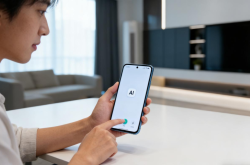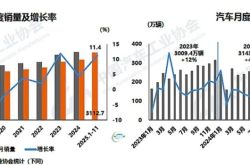iPhone17: Struggling with AI, Yet Aiming to Captivate Apple Enthusiasts?
![]() 09/10 2025
09/10 2025
![]() 452
452
Lagging behind other tech behemoths in the AI race, Apple is fervently crafting novel highlights and gimmicks for its latest iPhone lineup.
Clocking in at a mere 1 hour and 12 minutes, this year's Apple autumn event stands as perhaps the shortest in recent memory—devoid of the usual "Amazing!" exclamations, the iconic "One more thing" reveal, and AI was conspicuously absent. The iPhone17 series launch concluded hastily last night.
With AI advancements trailing behind competitors, Apple is banking on a slew of incremental upgrades and design tweaks for its new iPhones. For instance, the camera module has transitioned from the long-standing square "bathroom heater" aesthetic to a sleek rectangular form; the Plus model has been phased out in favor of the slimmest iPhone ever; and the entire range now boasts a 24-megapixel front camera and 120Hz high-refresh-rate displays.
Yet, the question remains: Can Apple rely on these modest enhancements to sway its fanbase without mastering AI?
01 Four Models, Three Styles
If distinguishing design changes in previous iPhone iterations was a challenge, then this time around, Tim Cook has clearly upped his game.
The iPhone17 Pro retains its trio of cameras, but Apple has reconfigured them into a rectangular array, elongating the entire Deco area and relocating the flash and LiDAR scanner to the side. This design shift, while not revolutionary—Google's recently launched Pixel 10 and even Xiaomi's four-year-old Mi 11 Ultra sport similar setups—might just be enough to entice iPhone loyalists to upgrade, given that the new look will be immediately noticeable to onlookers.
Even the iPhone17 Pro's rear panel embraces a spliced design, integrating a ceramic glass section amidst an otherwise aluminum body. Apple's rationale for this move is wireless charging compatibility, though, frankly, the execution appears somewhat disjointed.
Beyond these aesthetic flourishes, the camera and screen have undergone notable upgrades.
For instance, the entire iPhone17 lineup now features a 24-megapixel front camera, enabling horizontal selfies without the need to rotate the device. The iPhone 17 Pro's triple-camera system has been upgraded to 48 megapixels, supporting 8x optical zoom and 40x digital zoom. While these figures may not dazzle compared to rivals, they represent significant strides over previous iPhone iterations.
Additionally, the iPhone 17 series comes standard with 120Hz dynamic high-refresh-rate displays. While budget Android phones priced between $150-$300 already offer 120Hz screens, Apple, known for its meticulous "scalpel-like" precision, has finally extended this feature to its standard iPhone models.
The most talked-about model of the evening was the iPhone Air (not dubbed the iPhone 17 Air). With a mere 5.6mm thickness, weighing 165g, and sporting a 6.5-inch screen, it claims the title of the thinnest and lightest iPhone ever.
Moreover, the iPhone Air eschews the physical SIM card slot in favor of eSIM technology. In fact, Apple began phasing out SIM card slots in the U.S. market with the iPhone14 in 2022, but the iPhone Air marks Apple's first global eSIM-only model.
However, considering that numerous carriers worldwide still do not support eSIM, the iPhone Air's usability may be limited in many regions. In China, for instance, only China Unicom currently offers eSIM support, and activation necessitates a visit to a Unicom store. Unicom, which once reaped the benefits of the iPhone4's popularity, now stands to gain from the iPhone Air's release.
Yet, beyond its slim profile, the iPhone Air has several drawbacks. Its pursuit of thinness has resulted in a single rear camera, significantly compromising imaging capabilities. Battery capacity has also been sacrificed, dropping below 3000mAh. Apple's solution? Purchase a magnetic battery pack.
Interestingly, Samsung released the Galaxy S25 Edge in May, also emphasizing an ultra-thin design with a thickness of just 5.8mm and a weight of 163g. Samsung hopes to gauge market response with this model before potentially replacing its Plus lineup entirely.
Unfortunately, sales of the Samsung Galaxy S25 Edge have been lackluster, falling far short of expectations and prompting Samsung to slash production.
Apple faces similar challenges. Past user surveys indicate that phone thinness is not a top priority for consumers, who still prioritize price, battery life, and camera quality when purchasing a phone. Whether users are willing to sacrifice battery life and camera performance for a lackluster thin design remains to be seen.
Nevertheless, Apple has compelling reasons for this approach. On one hand, previous iPhone Plus models have consistently underperformed in sales, suffering from an awkward positioning that left them inferior to both higher and lower-tier models. Replacing the Plus with a newly positioned product like the Air makes strategic sense.
On the other hand, introducing a slim Air model lays the groundwork for next year's foldable iPhone, which demands stringent thinness requirements.
Some even speculate that Apple is using the slim phone to divert attention from its nascent AI projects. After all, directly altering product design might yield quicker results in boosting iPhone sales than investing time, effort, and money into developing large AI models.
However, unlike previous years where iPhone models released in the same year maintained a consistent design language, the iPhone17 series features highly distinct designs for each model. The standard iPhone17 retains the iPhone16's design, the iPhone Air adopts a titanium frame with a rectangular camera module, and the iPhone17 Pro builds on this with a spliced panel. When placed side by side, the four models appear starkly different.
This design divergence seems quite uncharacteristic of Apple.
02 The Vanishing AI
Based on previous teasers, the outside world had mentally prepared for AI not to be the main focus of the event. However, few expected AI to be almost entirely absent during the iPhone17 series launch.
The sole AI-related demonstration during the event occurred during the new AirPods announcement, showcasing real-time cross-language translation via headphones.
On the iPhone17's product page, we found just one AI-related mention: "Prepared for Apple Intelligence."
A year ago, during the iPhone16 launch, AI was the star of the show. Tim Cook proudly showcased Apple Intelligence, demonstrating various AI scenarios, including summarizing information, refining email wording, snapping photos of restaurants to find information, generating custom emojis via AI, and even mentioning a more coherent and fluid Siri.
Yet, during the iPhone17 launch, Apple seemed reluctant to mention these features.
However, insights from Apple's Worldwide Developers Conference (WWDC) held in June reveal Apple's efforts, including visual intelligence to recognize information in cameras or screenshots, multilingual real-time translation, and cross-app connectivity with automatic triggering of reminders, order tracking, and other functions without manual setup.
For example, the Reminders app in iOS 26 supports AI-powered automatic categorization, intelligently grouping unorganized task lists into sections like "Work," "Home," "Health," etc. But this seems like a minor application unlikely to make waves.
In contrast, Google's recently released Pixel10 showcased its AI capabilities throughout the event, including its pride and joy, Magic Cue, which integrates apps like Gmail, Calendar, screenshots, and messages, with AI providing operational suggestions.
For instance, if someone texts you asking for flight details, Magic Cue can display that information from your calendar with a single tap. When asked how long until you arrive at a meeting, Magic Cue checks your location and calendar to calculate the arrival time. Or, when calling an airline, Magic Cue can directly display booking information during the call.
Apple, facing delayed expectations, has become more cautious in promoting its AI capabilities. In July, Apple's Chinese website removed all mentions of "Apple Intelligence" from the iOS 26 introduction page, along with the previously noted statement that "Apple Intelligence will be available in the future."
03 Where Is Apple's AI Headed?
Last June, at Apple's WWDC, Tim Cook confidently unveiled Apple's intelligent strategy, showcasing a wave of new AI features. The outside world expected Siri to undergo an epic evolution soon.
However, Apple encountered a series of setbacks in AI, with the new Siri facing repeated delays. Apple even temporarily pulled down previously aired advertisements. In early 2025, frustrated, Apple decided to remove JG, who had led Siri for seven years, and handed over responsibility to the head of Vision Pro.
Apple's current dilemma lies in two areas. On one hand, self-developed large models are progressing slowly. Initially, Apple aimed to parallelize the existing Siri system with a large language model system. However, this hybrid architecture consistently failed to meet Apple's quality standards. Siri's early architecture, designed for simple commands, couldn't handle modern large language models.
Simultaneously, under immense pressure and controversy, Apple's talent is rapidly departing. Several core members of the foundational model team have jumped ship to competitors, while Apple's distinguished engineer, Pang Ruoming, was poached by Meta with a salary package exceeding $200 million.
On the other hand, partnerships with external model vendors have left Apple in a passive position, not only losing face but also struggling to compete with rivals. However, practical challenges have forced Apple to seek external assistance. Previously, Apple integrated ChatGPT, with many Siri queries now answered by ChatGPT. After the new head took over, Apple briefly hoped to collaborate with Anthropic, but Anthropic's terms were deemed unacceptable. The latest news suggests Apple is likely to partner with Google to revamp Siri.
In the Chinese market, Apple has already partnered with Alibaba and Baidu, with expectations to roll out AI services to Chinese users by the end of the year. Alibaba reportedly helped Apple develop an on-device AI system capable of analyzing and adjusting Apple's AI models on iPhones, iPads, and Macs to ensure compliance with local regulatory requirements. Meanwhile, Baidu supports Siri and visual intelligence functions, similar to OpenAI and Google's roles in the U.S. version of Apple Intelligence.
As a wealthy and powerful tech giant, why has Apple found itself so passive in the AI era? Renowned Apple analyst Mark Gurman revealed in a lengthy article the indecisiveness of Apple's senior leadership regarding AI strategy and internal conflicts among departments. For instance, Apple's software head viewed AI as a supplementary feature rather than a core selling point, unwilling to go all-in. Meanwhile, AI executives recruited from Google struggled to integrate into the management.
Additionally, Apple's once-proud user privacy has now become an obstacle to AI development. Despite possessing billions of active devices generating vast amounts of user behavior data daily, Apple's researchers are limited to using third-party authorized datasets and synthetic data due to strict privacy protection clauses.
Crisis signs are emerging. In a testimony, an Apple executive revealed that traffic to Google Search from Apple's Safari browser declined for the first time in April 2025, stating, "This hasn't happened in 22 years. AI is the reason." This implies that more users are relying on large models for information. This revelation once caused Google's stock price to plummet.
To avoid falling behind in the future, Apple has formed a new team called "AKI" to develop AI search. Meanwhile, Apple has largely abandoned plans to acquire AI search unicorn Perplexity. The latest news indicates that Apple is developing a completely revamped Siri version, internally dubbed "LLM Siri," expected to launch as early as next spring.
However, the good news is that AI isn't currently a decisive factor for users when choosing a smartphone.
A survey by U.S. tech media CNET found that only 11% of American users would upgrade their device due to AI features, down from 18% last year. This means Apple doesn't need to worry about users switching to phones with stronger AI capabilities for now. Instead, most users still focus on several core aspects when purchasing a phone: lower price, longer battery life, larger storage, and better camera quality.
But the outside world believes that if Apple continues to lag behind competitors in AI, it will soon face its own "BlackBerry moment." Therefore, in early August, Tim Cook held a rare all-hands meeting at the Steve Jobs Theater, conveying Apple's determination to succeed in the AI era while attempting to boost morale among demoralized internal employees.
"Apple rarely pioneers a category. Before the Mac, there were PCs; before the iPhone, there were smartphones; before the iPad, there were many tablets; before the iPod, there were MP3 players. The key is that Apple created the modern versions of these product categories," Cook said. "I believe we'll do the same with AI."
Perhaps, as a senior analyst at IDC remarked, "If you arrive late, it doesn't matter, but you'd better make a grand entrance."





